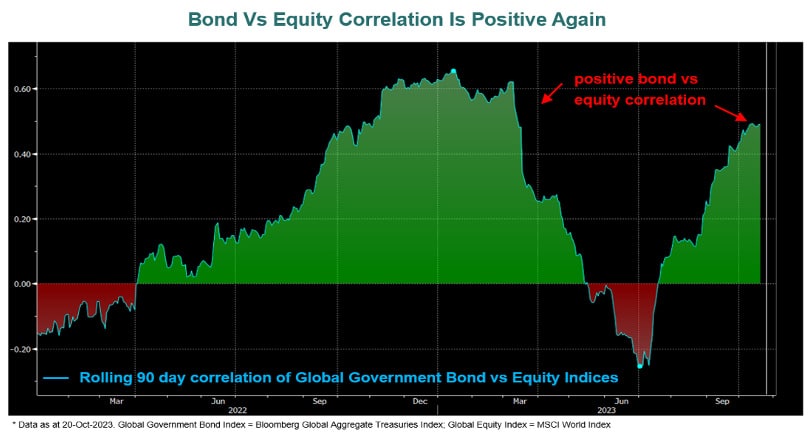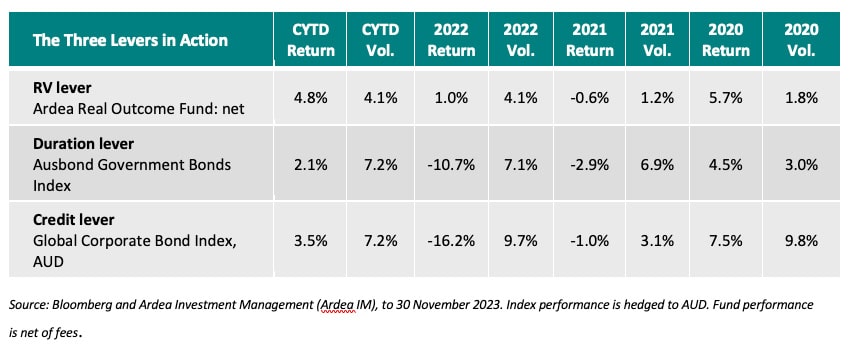
Within fixed income, there are two well-known levers, duration and credit. However, there is also a lesser known third lever, Pure Relative Value investing. Scott Osborne, Investment Specialist at Ardea Investment Management, explores how this third lever provides compelling diversification benefits for investors when blended with duration and credit.
Investors have faced tremendous change over the past decade and perhaps an even more radical shift in recent years as ultra-low inflation and zero, even negative, interest rates gave way to sky-high pricing and aggressive tightening by central banks in both the developed and emerging world. Rapidly rising interest rates have been particularly painful for fixed income investors but have also contributed to equity market uncertainty and created dislocations in the relationship between asset classes.
Central banks have suffered criticism for their response to the challenge of rising inflation and dwindling economic growth, and while some of this may be unfair, central banks in fixed income markets have undeniably shifted from suppressors of market volatility to volatility amplifiers.
Until recently, central banks were quick to intervene whenever there was some form of market stress, either in the shape of interest rate cuts or quantitative easing, and that intervention was easy to justify given their objectives of price stability and economic growth were perfectly aligned. Inflation was running well below target, so whatever policy makers did to facilitate stable prices was consistent with supporting growth. These objectives are now misaligned, with the options available to tame inflation undesirable from the perspective of economic prosperity.
Also read: A Soft Landing And Friendlier Central Bank Stance Bode Well
Bond yields in a structurally higher volatility regime
These conflicting objectives, the associated policy uncertainty, and central banks aggressively running down their pandemic-era bond portfolios are why we consider the worlds’ reserve banks to be amplifiers of volatility. This also means interest rates and bond yields are in a structurally higher volatility regime than they have been for most of the post Global Financial Crisis era (since 2008).
Furthermore, uncertainty about inflation and the path of interest rates introduces a more variable correlation between bonds and equities. This is particularly relevant for multi-asset portfolio managers because the composition of their fixed income allocations now carries more weight. Historically, investors could simply rely on duration (government bonds) to diversify equity risk, but today that duration component is more volatile and also has a more volatile relationship with equities.
Fixed income investors face a similar dilemma, with corporate bonds suffering the same upward pressure on yields (downward pressure on prices) as government issued debt, but with greater potential for default. This means the two traditional levers of fixed income portfolio management – duration and credit – have more uncertainty.
Pure Relative Value (RV) investing: An additional lever
Pure RV investing does not rely on conventional fixed income sources of return and is not impacted by the level of bond yields regardless of whether they are high, low, or even negative. Nor is it reliant on corporate credit risk or a fund managers’ ability to forecast the direction of interest rates. Instead, the Pure RV approach focuses on pricing inconsistencies between closely related securities – it offers investors an additional lever.
The global fixed income market contains a huge array of securities that are explicitly linked to each other by well-defined relationships. In an efficient market, these securities would always be consistently priced with one another, but the fixed income market is not efficient. Underlying structural factors such as regulation, mandate restrictions, and varying investor use objectives cause market participants to transact for reasons other than profit maximisation.
As such, we continually observe pricing inconsistencies between closely related securities that have very similar risk characteristics. These pricing inconsistencies can be isolated using a wide range of risk management tools, including derivatives, which strip out unwanted market risk allowing the strategy to target the generation of positive returns regardless of the level of bond yields or the direction of interest rates.
Incorporating Pure RV investing can upgrade the portfolio diversification toolkit as seen in the following table.
The power of three
In a period of heightened market volatility, incorporating a pure relative value (RV) investing element to fixed income allocations can offer investors compelling diversification benefits when blended with duration and credit. It offers investors a much needed third lever, which over the long term, can result in superior portfolio construction and market performance. When the two traditional levers of fixed income portfolio management – duration and credit – face more uncertainty, it may pay to embrace the power of three.



































